
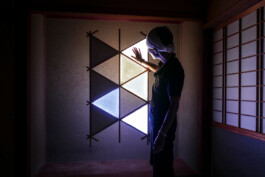
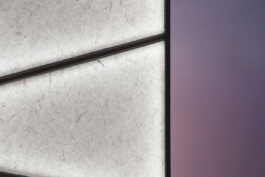

To highlight the innovative spirit of traditional Japanese paper crafts, the team worked on an unorthodox addition to the recipe. This transforms the paper into sensitive, electricity-conductive surfaces responsive to touch, proximity, and humidity.
Project partners:
MONO Japan, Sekishu Washi Kaikan, Sekishu Washi Kubota, Nishita Washi Kobo
During a 2019 AIR in Shimane (JP), Cream on Chrome had the chance to tie in with the 1500 year old UNESCO intangible heritage of “Sekishu Washi” paper making. How to deal with such craft heritage today—conserve or update? In Japanese architecture, handmade paper was once widely used to build shoji paper walls (famous for their interplay with natural light), but has lost popularity in modern homes, and the ancestral knowledge is increasingly being forgotten.
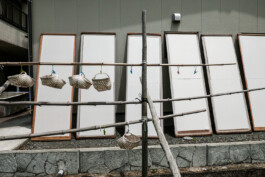


Ideas for possible applications materialized in multiple prototypes of lamps and in 2021 in the creation of a touch-interactive glowing room divider “Katagami”. This paravent, a seamless fusion of washi, Japanese woodcraft and digital technology transcends traditional boundaries. It harnesses the ethereal interplay of light and paper, offering a novel sensory experience that bridges ancient craftsmanship with new technological developments.
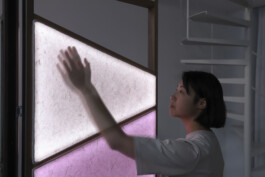


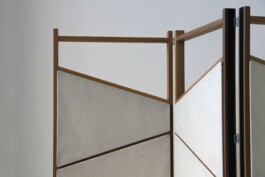
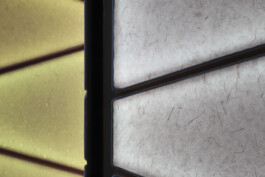
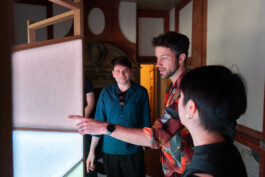
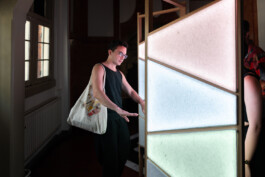
We aimed to maintain the superb quality of handmade paper while exploring futuristic advancements. A major challenge was adding a new ingredient without altering the traditional production process. Initial experiments with thin wire patterns or copper strands succeeded in the final product but interfered with paper scooping or impaired quality. Thanks to the tireless support of artisans, we discovered a way to incorporate the thinnest carbon fiber strands seamlessly. The result is slightly greyer than typical “Sekishu Washi” but otherwise very similar. Various possibilities were found to integrate the carbon fiber in aesthetically pleasing ways.
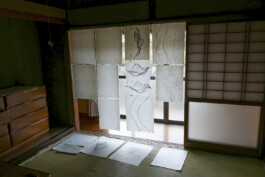
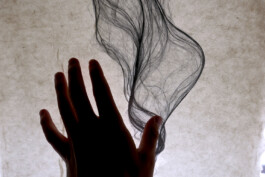
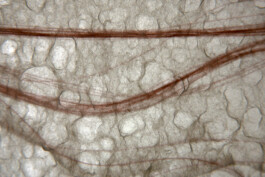
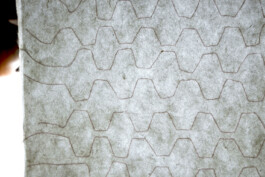
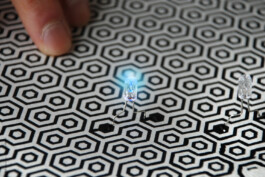

Our goal was not necessarily to create a marketable product. The focus was to collaborate on something that showcased the incredible potential of this venerable craft while exploring a new, craft-inspired high-tech aesthetic. However, the positive reception inspired us to delve deeper into the possibilities of conductive paper, together with the artisans.
Since 2019, we have presented various interactive installations made with “Sensory Washi”—such as at Dutch Design Week, MONO Japan, and GLUE Amsterdam—highlighting the fusion of tradition and innovation in a truly unique way.
YEAR
2019
LOCATIONS
Sekishu Washi Centre (JP), MONO Japan (NL), GLUE Festival (NL)
DESIGN TEAM
Jonas Althaus, Martina Huynh
RESPONSIBILITIES
Material Innovation, Product Design, Electronic Design, Coding
SUPPORTED BY
MONO Japan
PHOTOGRAPHER
Cream on Chrome




To highlight the innovative spirit of traditional Japanese paper crafts, the team worked on an unorthodox addition to the recipe. This transforms the paper into sensitive, electricity-conductive surfaces responsive to touch, proximity, and humidity.
Project partners:
MONO Japan, Sekishu Washi Kaikan, Sekishu Washi Kubota, Nishita Washi Kobo
During a 2019 AIR in Shimane (JP), Cream on Chrome had the chance to tie in with the 1500 year old UNESCO intangible heritage of “Sekishu Washi” paper making. How to deal with such craft heritage today—conserve or update? In Japanese architecture, handmade paper was once widely used to build shoji paper walls (famous for their interplay with natural light), but has lost popularity in modern homes, and the ancestral knowledge is increasingly being forgotten.



Ideas for possible applications materialized in multiple prototypes of lamps and in 2021 in the creation of a touch-interactive glowing room divider “Katagami”. This paravent, a seamless fusion of washi, Japanese woodcraft and digital technology transcends traditional boundaries. It harnesses the ethereal interplay of light and paper, offering a novel sensory experience that bridges ancient craftsmanship with new technological developments.







We aimed to maintain the superb quality of handmade paper while exploring futuristic advancements. A major challenge was adding a new ingredient without altering the traditional production process. Initial experiments with thin wire patterns or copper strands succeeded in the final product but interfered with paper scooping or impaired quality. Thanks to the tireless support of artisans, we discovered a way to incorporate the thinnest carbon fiber strands seamlessly. The result is slightly greyer than typical “Sekishu Washi” but otherwise very similar. Various possibilities were found to integrate the carbon fiber in aesthetically pleasing ways.






Our goal was not necessarily to create a marketable product. The focus was to collaborate on something that showcased the incredible potential of this venerable craft while exploring a new, craft-inspired high-tech aesthetic. However, the positive reception inspired us to delve deeper into the possibilities of conductive paper, together with the artisans.
Since 2019, we have presented various interactive installations made with “Sensory Washi”—such as at Dutch Design Week, MONO Japan, and GLUE Amsterdam—highlighting the fusion of tradition and innovation in a truly unique way.
PROJECT TYPE
Residency
YEAR
2019
LOCATIONS
Sekishu Washi Centre (JP), MONO Japan (NL), GLUE Festival (NL)
DESIGN TEAM
Jonas Althaus, Martina Huynh
RESPONSIBILITIES
Material Innovation, Product Design, Electronic Design, Coding
PHOTOGRAPHER
Cream on Chrome